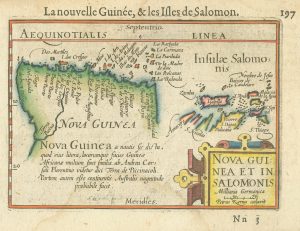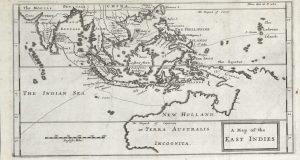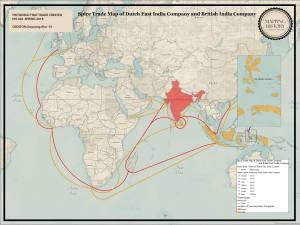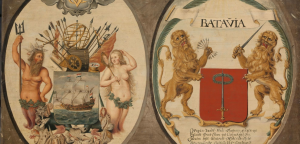3 Conquistadors, traders, and pirates seek their fortunes in the Pacific
Spanish possessions in the Americas (and the desire to convert American silver into Asian goods) led to a growing Spanish presence in the Pacific during the sixteenth century. The wealth of the New World, and the possibility of trade routes reaching from Europe to Asia, were of interest to Europeans. In 1494, in response to Christopher Columbus’s first voyage, the Spanish and Portuguese monarchs signed the Treaty of Tordesillas and divided the unknown world between them. That Treaty represented increasing European interest in reaching and exploiting the world beyond Europe, and in the decades after its signing Spain succeeded in deriving wealth from its American possessions, and Portugal from its trading posts in Asia. Such successes drew other European states to the shores of the Pacific, and across that ocean.
The known wealth of Asia and the recently discovered mines of the Americas reinforced European expectations that profit would reward exploration. Medieval maps and tales had created the notion of a rich southern continent to balance the known landmasses in the northern hemisphere, and exploration of the South Sea promised to reveal that continent and allow access to its resources. In the wake of Ferdinand Magellan, other Spanish explorers ventured into the Pacific, and often they found signs that confirmed European expectations of wealth waiting to be discovered.

Spanish explorers set out across the Pacific Ocean in the 1520s, scouting for a viable route between Mexico and Asia. As a result, they encountered the coast of New Guinea, and the islands near it. In 1528 Spanish navigator Álvaro de Saavedra Cerón named islands close to New Guinea the Islas de Oro (Golden Isles). New Guinea itself was named by Iñigo Ortiz de Retes in 1545, and that name first appeared on a map in 1569. Both Spanish names indicate that Spanish explorers sought (and thought they had found) gold in the Pacific (the name New Guinea refers to Guinea in Africa, a region known for its gold). In 1567 Álvaro de Mendaña de Neira was the first European to record seeing the Solomon Islands, and he named them for the biblical figure of King Solomon, thinking he had located the source of Solomon’s legendary wealth.
Analysis of Mendaña’s voyages provides insights into both European expectations and the difficulties of accurately charting a large ocean with the technology available. Mendaña’s first voyage left Peru in 1567, in part inspired by Incan traditions of wonderous islands to the west. That voyage lasted twenty-two and a half months, with six of those months spent in the Solomon Islands. That extended contact with the region and the local people led to instances of cultural misunderstanding, disputes over local resources, and violent conflict. Despite his experiences in the Solomon Islands, and despite a lack of concrete supporting evidence, on his return to Spanish possessions in the Americas in 1569 Mendaña praised his discoveries, and they were widely believed to be rich in gold and spices. In addition, Mendaña misplaced the Solomon Islands on Spanish maps: imperfect technology allowed him to underestimate their distance from Spanish possessions in the Americas.
Mendaña was eager to return to the islands he had located, but his second expedition to the Pacific did not set out until 1595, 26 years after his return from his first expedition (and after Francis Drake had completed his circumnavigation). Indicating the difficulties of navigating the Pacific in this period, when the expedition reached the Marquesas Islands Mendaña feared they had travelled too far west and had missed re-visiting the Solomon Islands. (In fact, the Solomon Islands are located c.6500km west of the Marquesas Islands.) The Spanish spent two weeks in the Marquesas Islands and caused approximately 200 deaths. The Spanish voyaged on, and reached Santa Cruz (now part of the Solomon Islands, but unfamiliar to the Spanish). There Mendaña died while his attempted colony descended into violence and chaos. Command quickly passed to Mendaña’s widow Isabel Barreto de Castro and the pilot Pedro Fernandez de Queirós, and the expedition was forced to abandon its hopes of establishing a colony. It sailed for the known port of Manila.
Queirós returned to explore the Pacific in 1603, seeking the Southern Continent. His expedition encountered a number of islands in central Polynesia, then travelled on to the New Hebrides where he attempted to found a colony. That colony failed, and Queirós returned to the Americas, although one of the expedition’s ships, under the command of Luís Vaz de Torres, instead sought refuge in the Philippines. Not discouraged by his two Pacific experiences, Queirós sought to return, but he could not find backers for a further voyage.
After the experiences of Mendaña and Queirós there were no further Spanish attempts to found colonies in the Solomon Islands. However, the Manila Galleon continued to ply its route across the north Pacific Ocean. Spain’s settlements on the Pacific coast of South America, and the concentration of American silver in the Galleon lured voyagers from other European states to the Pacific. Among those voyagers were English navigators, and while they often operated with at least some veneer of legality, they came to the Pacific intending to seize American silver and gold from the Spanish.

The first in a series of English voyagers was Francis Drake, whose expedition was the second European circumnavigation of the globe. Drake at times operated as a pirate, a privateer (someone with a government license to loot representatives of an enemy state), and a captain of the British Navy. In 1577 Drake set out from England with a fleet of ships intending to reach the Pacific. After passing through the Straits of Magellan he was driven far enough south to realise that South America was not connected to the Southern Continent, thwarting his plans of establishing trade with its inhabitants. Instead, Drake set about plundering Spanish ports in Peru, and captured a galleon on its way to join the Manila Galleon fleet. He then sought to return to Europe by finding the northwest passage thought to exist in the north of North America. No navigable northwest passage existed at that time, and after spending a month in the region of California he set off across the Pacific, unable to return the way he had come because of the Spanish reaction to his Peruvian raids. On his return, Drake increased England’s knowledge of the wider world, mostly through information stolen from captured Spanish and Portuguese vessels. His voyage distracted the Spanish from Pacific exploration, as it demonstrated that Spain’s New World possessions were no longer protected from Old World rivals by distance alone.
Drake was not the last Englishman drawn to the Pacific by Spanish American silver. He was quickly followed by Thomas Cavendish, who entered the Pacific in 1587, captured the Manila Galleon, and circumnavigated the earth. The next Englishman to emulate Drake was William Dampier, who first entered the Pacific in 1683. Dampier completed four voyages to the Pacific, and circumnavigated the world three times. Like Drake and Cavendish, Dampier was at times a pirate, at others a privateer, and even sometimes a naval captain. Like Drake and Cavendish, he succeeded in capturing a Manila Galleon, and like Drake and Cavendish he largely operated in known regions of the Pacific. However, Dampier was a gifted observer and writer and his 1697 book A New Voyage Round the World was a best seller. That book included mention of New Holland, and Dampier was the first English navigator to visit the Australian continent.
Dampier was followed by George Anson, who circumnavigated the world between 1740 and 1744, and also succeeded in capturing a Manila Galleon. While Anson was a naval captain, and ended his career as Admiral of the Fleet, his actions in the Pacific were of a pattern with those of Drake, Cavendish, and Dampier, marking over a century and a half of English interest in the Pacific as a source of plunder from Spain’s American possessions.

Company. 2019. By Doyoung Ahn and available in Elya J. Zhang’s Mapping History. Used with permission
At the same time that Spanish success in extracting precious metals from the Americas drew the English to the Pacific, the prospect of trade with Asia drew other groups of Europeans to the edge of the Pacific Ocean, and into encounters with the Australian continent. When the Netherlands declared its independence from Spanish rule in 1581, Philip II of Spain sought to exclude Dutch merchants from the trade with Asia they had previously enjoyed through their Portuguese and Spanish connections. Dutch voyagers sought to find routes to access known trading ports: they searched for a northeast passage, evaluated the Straits of Magellan, and investigated a route around the southern tip of Africa. From 1595 Dutch ships reached the East by way of the Cape of Good Hope at the southern tip of the African continent.

In 1602 the United East India Company (VOC) was founded in Amsterdam, and given a Dutch government monopoly on war, commerce, and trade between the Cape of Good Hope and the Straits of Magellan. Approaching from the west, the Dutch established a long-lasting presence in Asia, founding the port of Batavia (now Jakarta) in 1619. While the Dutch were focused on profiting from familiar Asian resources, their base at Batavia facilitated some expeditions of exploration, and the need to navigate to it safely prompted the mapping of the coast of New Holland (now Western Australia). Dutch mariners were generally disappointed in their encounters with New Holland, and sought to chart it in order to avoid it. Some Dutch explorers skirted around the south of the Australian continent, in rare Dutch attempts to locate the Southern Continent.
Spain’s interests in the Americas led to increasing European familiarity with the Pacific. As Spain extracted wealth from its American possessions, and used that wealth to promote trade with Asia, other European states were drawn to the fringes of the Pacific, and into the Pacific itself. English and Dutch voyages in the region differed in their objectives, but their presence marked an end to the early Spanish monopoly on European Pacific exploration.
Links
Explorer Journals
Dampier, William. A New Voyage Round the World. London: Adam and Charles Black Ltd, 1937. https://gutenberg.net.au/ebooks05/0500461h.html
Dampier, William. A Voyage to New Holland etc in the Year 1699. London: James and John Knapton, 1729. https://gutenberg.net.au/ebooks/e00046.html
Dampier, William. A Continuation of a Voyage to New Holland etc in the Year 1699. London: James and John Knapton, 1729. https://gutenberg.net.au/ebooks/e00047.html
Drake, Francis and Francis Fletcher. The World Encompassed by Sir Francis Drake: Being his Next Voyage to That to Nombre de Dios. London: Hakluyt Society, 1854. https://archive.org/details/worldencompassed16drak/page/n13/mode/2up
European History Primary Sources. “VOC Sea Voyages,” last updated March 11, 2012. http://primary-sources.eui.eu/website/voc-sea-voyagers
Mendaña de Neira, Alvaro de, Hernán Gallegos Lamero, Pedro Sarmiento de Gamboa, Gomez Hernandez Catoira. The Discovery of the Solomon Islands by Alvaro de Mendaña in 1568. Vol. 1. London: Hakluyt Society, 1901. https://archive.org/details/discoverysolomo01thomgoog/page/n12/mode/2upVolume I. London: Hakluyt Society, 1901
Mendaña de Neira, Alvaro de, Hernán Gallegos Lamero, Pedro Sarmiento de Gamboa, Gomez Hernandez Catoira. The Discovery of the Solomon Islands by Alvaro de Mendaña in 1568. Vol. 2. London: Hakluyt Society, 1901. https://archive.org/details/discoverysolomo00thomgoog/page/n18/mode/2up
Quiros, Pedro Fernandez de. The Voyages of Pedro Fernandez de Quiros 1595 to 1606. Translated by Clements Markham. London: the Hakluyt Society, 1904. https://www.gutenberg.org/files/41200/41200-h/41200-h.htm
Tasman, Abel Janszoon. Tasman’s Journal of his Discovery of Van Diemens Land and New Zealand in 1642 with Documents Relating to his Exploration of Australia in 1644. Amsterdam: Frederik Muller and Co., 1898. https://gutenberg.net.au/ebooks06/0600571h.html
WA Museum Collections and Research. “Maritime Journals [of Dutch Vessels Voyaging along the Western Australian Coast].” Accessed March 27, 2022. https://museum.wa.gov.au/online-collections/maritime-journals
Walter, Richard. Anson’s Voyage Round the World. London: Rivingtons, 1901. https://www.gutenberg.org/files/16611/16611-h/16611-h.htm
Maps and online resources
Hondius, Jodocus. Vera Totius Expeditionis Nauticae. Amsterdam. c.1595.
Museo Naval, Madrid. [Exploration of the Pacific in the sixteenth and seventeenth centuries.] 2013.
Princeton University Library. “Jacob Roggeveen, 1659–1729.” Last updated 2010.
Video material
Open access secondary sources
Duivenvoorde, Wendy Van. “Dutch Seaman Dirk Hartog (1583–1621) and his Ship Eendracht.” The Great Circle, 38, no. 1 (2016):1-31. https://www.jstor.org/stable/26381208
Forrest, Peter. The Tiwi Meet the Dutch: The First European Contacts. Darwin: Tiwi Land Council, 1995. https://www.tiwilandcouncil.com/documents/Uploads/TheTiwiMeetTheDutch_Peter%20Forrest1995.pdf
Gaastra, Femme S. “The Dutch East India Company: A Reluctant Discoverer.” The Great Circle, 19, no. 2 (1997): 109-123.https://www.jstor.org/stable/41555332
Gibbs, Martin. “Beyond the New World – the Failed Spanish Colonies of the Solomon Islands,” in Historical Archaeology and the Importance of Material Things II, edited by Julie M. Schablitsky and Mark P. Leone, 143-166. Rockville, MD: The Society for Historical Archaeology, 2011. https://www.academia.edu/25010148/Beyond_the_New_World_the_failed_Spanish_colonies_of_the_Solomon_Islands
Johnson, R. Wally. “Volcano Sightings by European Navigators: 1528-1870,” in Fire Mountains of the Islands: A History of Volcanic Eruptions and Disaster Management in Papua New Guinea and the Solomon Islands. Edited by R. Wally Johnson. Canberra: ANU Press, 2013. https://press-files.anu.edu.au/downloads/press/p223471/html/ch02.xhtml?referer=&page=9
Neill, Anna. “Buccaneer Ethnography: Nature, Culture, and Nation in the Journals of William Dampier.” Eighteenth-Century Studies 33, no. 2 (Winter 2000): 165-180. https://www.jstor.org/stable/3005368033, no,2 (2000): 165-180
Prescott, Dorothy F. “The Discovery and Mapping of Australia’s Coasts: The Contribution of the Dutch, French and British Explorer Hydrographers.” Paper presented at the 400 Years of Mapping Australia Conference Darwin 2006. https://www.xnatmap.org/adnm/conf_06_11/c06/aPaper%2001.pdf
Russell, Lynette, and Leonie Stevens. “A Tale of Subterfuge, Rivalry, Napoleon and Snakes: How the NSW State Library Came to Own the Map of Abel Tasman’s Voyages.” The Conversation, March 3, 2022. https://theconversation.com/a-tale-of-subterfuge-rivalry-napoleon-and-snakes-how-the-nsw-state-library-came-to-own-the-map-of-abel-tasmans-voyages-177069
Williams, Gary C. “William Dampier: Pre-Linnean Explorer, Naturalist, Buccaneer.” Proceedings-California Academy of Sciences 55 (2005): 146-166. https://www.researchgate.net/profile/Gary-Williams-13/publication/228629957_William_Dampier_Pre-Linnean_Explorer_Naturalist_Buccaneer/links/0046353a9c9ac72e36000000/William-Dampier-Pre-Linnean-Explorer-Naturalist-Buccaneer.pdf
Other Secondary Sources
Gibbs, M. “The Failed Sixteenth Century Spanish Colonizing Expeditions to the Solomon Islands, Southwest Pacific: The Archaeologies of Settlement Process and Indigenous Agency.” In Archaeologies of Early Spanish Colonialism, edited by S. M. Monton and R. Apen Cruz-Beccoral . New York: Springer-Verlag, 2016.
Masuda, Matt. Pacific Worlds a History of Seas, Peoples, and Cultures. Cambridge: Cambridge University Press, 2011.
Parker, Katherine. “Chasing Legacies: William Dampier and Joseph Banks in Comparative Perspective.” Journal for Maritime Research 21 (2019): 5-22.
Parthesius, Robert. Dutch Ships in Tropical Waters the Development of the Dutch East India Company (VOC) Shipping Network in Asia 1595-1660. Leiden: Brill, 2012.
Shaw, Lindsey and Wendy Wilkins, eds. Dutch Connections: 400 Years of Australian-Dutch Maritime Links 1606-2006. Canberra: Australian National Maritime Museum, c.2006.
Sheehan, Colin. “Voyages to the South Land: Dutch Explorations of the Queensland Coast.” Queensland History Journal 21, no. 2 (2010): 72-87.
Thrower, Norman J.W. “The Lure of the Prize: The British Pursuit of the Spanish Treasure Galleons.” Mercator’s World 8, no.2, (March-April 2003).
Williams, Glyn. The Prize of All the Oceans: The Dramatic Story of Commodore Anson’s Voyage Round the World and How He Seized the Spanish Treasure Galleon. New York: Viking Penguin, 2000.

